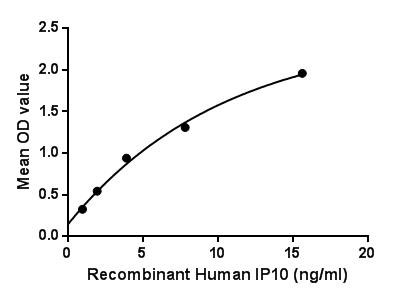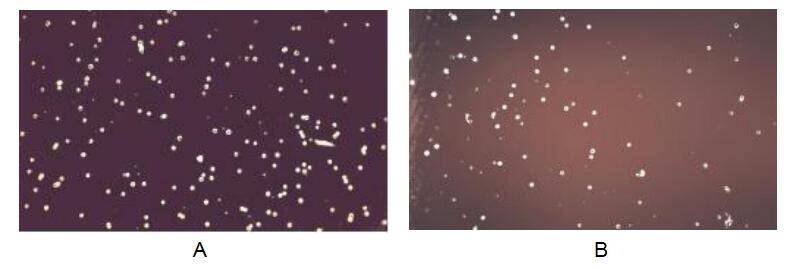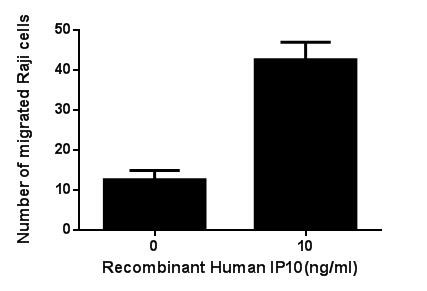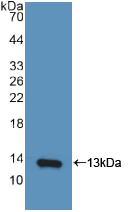Active Interferon Gamma Induced Protein 10kDa (IP10) 

CXCL10; C7; IFI10; INP10; SCYB10; Crg2; GIP10; Mob1; Chemokine C-X-C Motif Ligand 10; Small Inducible Cytokine Subfamily B(Cys-X-Cys)Member 10
- UOM
- FOB US$ 302.00 US$ 756.00 US$ 1,512.00 US$ 4,536.00 US$ 11,340.00
- Quantity
Overview
Properties
- Product No.APA371Hu01
- Organism SpeciesHomo sapiens (Human) Same name, Different species.
- ApplicationsCell culture; Activity Assays.
Research use only - DownloadInstruction Manual
- CategoryCytokineTumor immunityInfection immunity
- Buffer FormulationPBS, pH7.4, containing 0.01% SKL, 5% Trehalose.
- Traits Freeze-dried powder, Purity > 95%
- Isoelectric Point10.4
Sign into your account
Share a new citation as an author
Upload your experimental result
Review

Contact us
Please fill in the blank.
Activity test

Figure. The binding activity of IP10 with IGFBP7.
Interferon gamma-induced protein 10 (IP10) also known as C-X-C motif chemokine 10 (CXCL10) or small-inducible cytokine B10 is an 8.7kDa protein that in humans is encoded by the CXCL10 gene. C-X-C motif chemokine 10 is a small cytokine belonging to the CXC chemokine family. IP10 secreted by several cell types in response to IFN-γ, has been attributed to several roles, such as chemoattraction for monocytes/macrophages, T cells, NK cells, and dendritic cells, promotion of T cell adhesion to endothelial cells, antitumor activity, and inhibition of bone marrow colony formation and angiogenesis. Besides, Insulin Like Growth Factor Binding Protein 7 (IGFBP7) has been identified as an interactor of IP10, thus a binding ELISA assay was conducted to detect the interaction of recombinant human IP10 and recombinant human IGFBP7. Briefly, VDR were diluted serially in PBS, with 0.01% BSA (pH 7.4). Duplicate samples of 100uL were then transferred to IGFBP7-coated microtiter wells and incubated for 2h at 37℃. Wells were washed with PBST and incubated for 1h with anti-IP10 pAb, then aspirated and washed 3 times. After incubation with HRP labelled secondary antibody, wells were aspirated and washed 3 times. With the addition of substrate solution, wells were incubated 15-25 minutes at 37℃. Finally, add 50µL stop solution to the wells and read at 450nm immediately. The binding activity of IP10 and IGFBP7 was shown in Figure 1, and this effect was in a dose dependent manner.

Figure. The chemotactic effect of IP10 on Raji cells.
Chemotaxis assay used 24-well microchemotaxis system was undertaken to detect the chemotactic effect of IP10 on the Raji cell line. Briefly, Raji cells were seeded into the upper chambers (150μL cell suspension, 106 cells/mL in RPMI 1640 with FBS free) and IP10 (1ng/mL, 10ng/mL ,100ng/mL and 1000ng/mL diluted separately in serum free RPMI 1640) was added in lower chamber with a polycarbonate filter (8μm pore size) used to separate the two compartments. After incubation at 37℃ with 5% CO2 for 2h, the filter was removed, then cells in low chamber were observed by inverted microscope at low magnification (×100) and the number of migrated cells were counted at high magnification (×400) randomly (five fields for each filter). Result shows IP10 is able to induce migration of Raji cells. The migrated Raji cells in low chamber at low magnification (×100) were shown in Figure 2. Five fields of each chamber were randomly chosen, and the migrated cells were counted at high magnification (×400). Statistical results were shown in Figure 3. The optimum chemotaxis of IP10 occurs at 10-100ng/mL.
(A) Raji cells were seeded into the upper chambers and serum free RPMI 1640 with 10ng/mL IP10 was added in lower chamber, then cells in lower chamber were observed at low magnification (×100) after incubation for 1h;
(B) Raji cells were seeded into the upper chambers and serum free RPMI 1640 without IP10 was added in lower chamber, then cells in lower chamber were observed at low magnification (×100) after incubation for 2h.

Figure. The chemotactic effect of IP10 on Raji cells
Usage
Reconstitute in 10mM PBS (pH7.4) to a concentration of 0.1-1.0 mg/mL. Do not vortex.
Storage
Avoid repeated freeze/thaw cycles. Store at 2-8°C for one month. Aliquot and store at -80°C for 12 months.
Stability
The thermal stability is described by the loss rate. The loss rate was determined by accelerated thermal degradation test, that is, incubate the protein at 37°C for 48h, and no obvious degradation and precipitation were observed. The loss rate is less than 5% within the expiration date under appropriate storage condition.
Increment services
-
 BCA Protein Quantification Kit
BCA Protein Quantification Kit
-
 Molecular Mass Marker for Protein
Molecular Mass Marker for Protein
-
 Monoclonal Antibody Customized Service
Monoclonal Antibody Customized Service
-
 Polyclonal Antibody Customized Service
Polyclonal Antibody Customized Service
-
 Protein Activity Test Experiment Service
Protein Activity Test Experiment Service
-
 Electrophoretic Mobility Shift Assay (EMSA) Experiment Service
Electrophoretic Mobility Shift Assay (EMSA) Experiment Service
-
 Buffer
Buffer
-
 Lentivirus Packaging Experiment Service
Lentivirus Packaging Experiment Service
-
 Adenovirus Packaging Experiment Service
Adenovirus Packaging Experiment Service
-
 Real Time PCR Experimental Service
Real Time PCR Experimental Service
-
 Spike RBD Protein (S-RBD)
Spike RBD Protein (S-RBD)
-
 Protein G
Protein G
-
 Protein A
Protein A
Citations
- Melatonin inhibits type 1 interferon signaling of toll-like receptor 4 via heme oxygenase-1 induction in hepatic ischemia/reperfusion.PubMed: 22288937
- Maternal circulating leukocytes display early chemotactic responsiveness during late gestationPubMed: PMC3561147
- Serum levels of selected chemokines in systemic lupus erythematosus patientsPubmed: 22461186
- The Immunosuppressant Protosappanin A Diminished Recipient T Cell Migration into Allograft via Inhibition of IP-10 in Rat Heart TransplantPubmed:24798458
- The G-Protein-Coupled Bile Acid Receptor Gpbar1 (TGR5) Inhibits Gastric Inflammation Through Antagonizing NF-κB Signaling PathwayPubMed: 26696888
- Hypoxia/ischemia promotes CXCL10 expression in cardiac microvascular endothelial cells by NFkB activationPubmed:26891076
- LPS alters the immuno-phenotype of glioma and glioma stem-like cells and induces in vivo antitumor immunity via TLR4.pubmed:28641579
- Serum biomarkers for predicting overall survival and early mortality in older patients with metastatic solid tumorsPubmed: 30952517
- Integrated Omics Reveals Tollip as an Aggravator and Therapeutic Target for Hepatic Ischemia‐Reperfusion Injury in MicePubmed: 31077413
- IL‑17A promotes CXCR2‑dependent angiogenesis in a mouse model of liver cancerPubmed: 31173199
- Inflammatory Responses of Astrocytes Are Independent from Lipocalin 2Pubmed: 32959226








